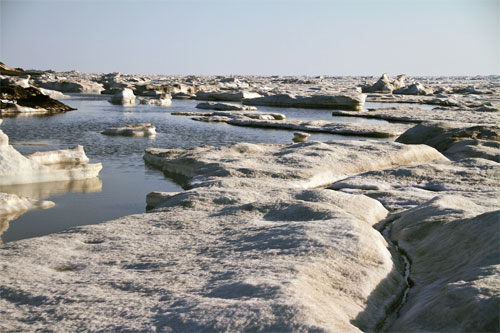
Work Starts on Critical Arctic Infrastructure LegislationBy MARY KAUFFMAN
February 24, 2014
Globally, the Arctic has roughly four million residents with an annual economy of $230 Billion. This is expected to increase in the future. Aside from certain areas in Norway and the western Russian Federation, the Arctic region remains vastly underserved by transportation, ports, communication and other critical infrastructure.
Arctic
SB 140 considered by Alaska Senate Labor and Commerce Committee last Wednesday came out of work completed by the 26 member Alaska Arctic Policy Commission (AAPC), co-chaired by Senator Lesil McGuire (R-Anchorage) and Representative Bob Herron (D-Bethel). In April 2012, the Alaska State Legislature established the Alaska Arctic Policy Commission to “develop an Arctic policy for the state and produce a strategy for the implementation of an Arctic policy.” According to a 2014 preliminary report by the Alaska Arctic Policy Commission, leaders in Norway, Denmark, Sweden, Finland, Iceland, Russia and Canada - and even non-Arctic nations like Singapore and China - all see the value of the Arctic. Meanwhile, many Americans still do not realize that the United States is an Arctic nation. Providing relevant information about the reality of the emerging Arctic, understanding and communicating the critical issues that affect this frontier, and instilling confidence in the promise of safety and prosperity is essential as Alaska and America move forward to ensure both. “The Arctic is our future alongside a healthy oil economy. Alongside the commercialization of our North Slope gas, the Arctic is the third leg of the stool that will be the future of our state,” Senator McGuire told committee members last week. “But without Arctic infrastructure, we will not be able to develop it. We have approximately $100 billion in private capital that we’ve identified through the AAPC, but in order for those private sector dollars to make their way into Alaska, we need some tools.” “Now it is time for Americans to turn their eyes to the North. The Federal Government is lagging behind the rest of the world on the Arctic,” said Senator McGuire last week. “Alaska is what makes the U.S. an Arctic nation. This bill ensures that Alaska will not lag behind. We need infrastructure which can serve critical needs including everything from tourism, oil spill response, search and rescue, and even national defense.” Senate Bill 140, sponsored by Senator McGuire, expands the Alaska Industrial Development and Export Authority’s (AIDEA) tool bag by extending the same authority for loans, loan guarantees, bonds and bond guarantees that it currently utilizes in the energy sector via the SETS fund in order to develop Infrastructure in the Arctic. The Sustainable Energy Transmission and Supply Development Fund (SETS) was created by Senator McGuire in 2012 under Senate Bill 25. The financing tools in SETS are currently leading to the first commercialization of Alaska’s North Slope natural gas while bringing much needed energy relief to Interior Alaska in the form of LNG trucking to Fairbanks. City Manager of Unalaska and AAPC Commissioner Chris Hladick, Assistant City Manager of Seward Ron Long, Trimble Strategies President and AAPC Commissioner Stephen Trimble, as well as First Infrastructure Managing Director and adviser to AIDEA Steven Klein all testified in support of SB140 at the Labor and Commerce Committee meeting last Wednesday. When Senator McGuire introduced SB 140 on January 27, 2014, she said, “The Alaskan Arctic is in desperate need of infrastructure development both for those who live there now, and for new opportunities that will come with the opening of the Arctic.” Senator McGuire said, “Globally, all eyes are on the Arctic because of the changing conditions which will bring new opportunities in shipping, tourism and resource development. In order for Alaskan’s to capitalize on this emerging situation, we need to think ahead and begin infrastructure development now, since we have lagged behind in the past.” The financing mechanisms in SB 140 are modeled after the Sustainable Energy Transmission and Supply Development Fund (SETS) that was created by Sen. McGuire in 2012 (SB 25). SB 140 would give AIDEA loan, bond, and bond guarantee authority for infrastructure development in the specific geographic region of the Arctic. This would increase incentives to encourage private investment and partnership with the state. The financing tools in the Sustainable Energy Transmission and Supply Development Fund (SETS) are currently leading to the first commercialization of Alaska’s North Slope natural gas while bringing much needed energy relief to Interior Alaska in the form of LNG trucking to Fairbanks. Senator McGuire said, “We can be just as innovative with Arctic Infrastructure financing. This will help pave the way for a vibrant 21st century economy in the Arctic.” In SB 140 the Arctic is defined as, “the area of the state north of the Arctic Circle, north and west of the boundary formed by the Porcupine, Yukon, and Kuskokwim Rivers, all contiguous seas, including the Arctic Ocean, and the Beaufort, Bering, and Chukchi Seas, and the Aleutian Chain.” SB140 is one of the first pieces of Legislation to be introduced as part of the work over the past year from the 26-member Alaska Arctic Policy Commission.
E-mail your news &
photos to editor@sitnews.us
|
||
